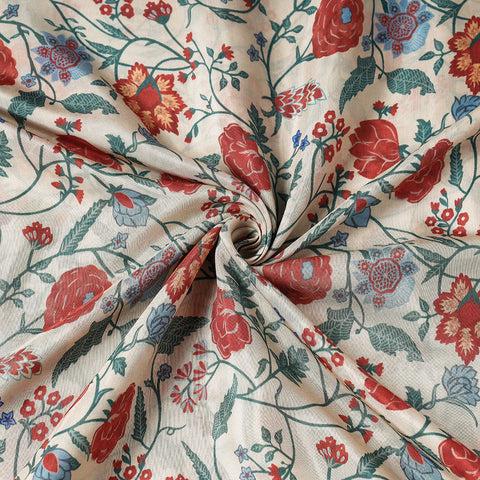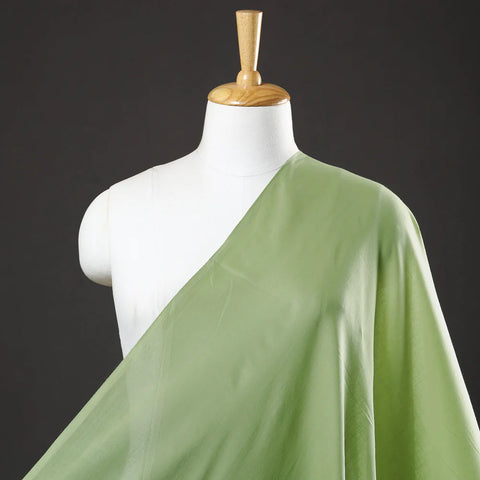India is known for its textile industry, and many of its textiles are very popular worldwide. With so many technological advances, there’s still an element of tradition in these textiles.
When we talk about regal attire, we think of something very intricate, exquisite, and an aura of elegance. Throughout history, there have been several textiles that royals have adorned. Some of them have been more popular than others. Not only do these popular fabrics have some of the finest materials used to weave them, but they are encased in skills that take years to perfect. Muslin is one of those fabrics which has seen quite an establishment throughout history.
The Muslin fabric is regarded as one of the finest textiles to ever exist. From traditional muslin cloth, regarded in the history of muslin fabrics, to the up-and-coming printed muslin fabric, this textile has seen its fair share of advancement.
The history of this textile is pretty old, rather ancient. It was highly popular among the royals and nobles' favourites. The higher the weight of muslin, the higher its value. Its most prominent feature is that it is fine, airy, and delicate enough to be passed through a ring and looks like layers of water have encased the body when worn.
Let’s dive deeper into the history textbook of textiles and uncover the mysteries of this exquisite fabric.
The History of Muslin
Evolved from a scandal that had quite a not-so-appealing opinion, the Muslin fabric was born in the city of Dhaka, Bangladesh. Later, it was imported to India and became renowned, with Bengal at the forefront. It was quite the treasure of its time, similar to how gold is to us today. It was simply of a musical and free-falling texture that just made anyone cherish it so dearly.
Muslin was a hit among notably wealthy figures, like the aristocrats, and has quite an ancient history attached to its existence. It was a symbol of nobility and was worn by kings and queens, and other royalties.
At first, it was crafted through a very tedious 16-step process. Weavers would weave this exquisite cloth with a technique that was called the discontinuous weft technique. Here, two layers – one which would hold the cloth and the other that would form the pattern – were used. It required a lot of labour, and the weavers had to be very skilful.
The cloth was so delicate and airy that it could easily pass through a ring and so diaphanous that one would barely feel as if they were draped in the fabric. Its yarn was obtained by cultivating it on the river banks of Bangladesh. Rivers such as Meghna and Shitalakshya are known for this. Its fibre was also obtained from regions such as Rajnagar, Kedapur, Dhaka, Dhamrai, Jangalbari, etc.
A pit loom was used to weave this soft, feathery, and delicate cloth. This has remained constant throughout history's records.
Muslin fabric was trendy during the Mughal rule; it was associated with being very poetic and used as a muse. Pure muslin fabric was also given names like abi–rawan, which meant flowing water, or baft–hawan, which meant woven air. These names were often used in tandem with describing the qualities of the fabric.
The Mughals did not only highly regard pure Indian muslin, but it was also said to be honourable enough to dress the statues of Greek Goddesses.
Indian muslin fabric was not only trendy and flourishing, but it was also a very popular export worldwide.
This fabric has garnered a lot of love. However, with the establishment of British Rule and instalments of factories, the industry was all but annihilated. This is because, what was previously the beauty of a labour-intensive technique, shifted to the monotony of the machines. Local culture and skills were lost in the midst.
While there were different types of muslin fabric, the Dhaka muslin was the finest of all. They were premium fabrics of this textile and were a sensation among notable historical figures like Marie Antoinette and Jane Austen.
However, by the 20th century, the Dhaka muslin fabric saw its evanescence in history. Very few of these fabrics existed by then, owned by the wealthy or available in museums. One must also reckon that its very tedious and onerous weaving technique was lost by that time too.
The Origins of the Muslin Fabric
While it was thought to have originated in the city of Mosul (which gave this fabric its name), they were imported into Europe from India. This city is where these traders were first exposed to this fabric. However, a similar kind of textile was being produced, which was not on par with muslin.
There have been references made to textiles similar to muslin through different historical records across the world. Records from the East, West, and Chinese civilisations find mentions of a cloth that is as gossamer as muslin, as though showcasing a spider’s web. This gave way to the assumption that this fabric has a rather ancient historical establishment.
It’s said that the trade between Indians and the Arabs might have led to the existence of muslin with them, as they later brought it over to trade goods from different cities like Egypt. This further led to its spread to the Greek and Roman empires too. Some regions of Asia also have a record of exports of this fabric.
However, India's history is associated with Bengal and its earlier production with Dhaka. In India, this fabric was called "Mal Mal" and is said only to weigh 10 grams. It’s so light and made with such finesse that 6 yards of this cloth can pass through a ring quickly.
Yet another particular relevance of this cloth is that it was regarded by Megasthenes, who was a Greek historian. Megasthenes was an ambassador of Chandragupta Maurya’s court and was commended for its adornment of Indians. It’s even seen in the terracotta figurines found in Bengal today. They give a picture of this fabric's appearance back in the day.
The Indian Muslin Fabric
As mentioned above, with the entrance of the East India Company, this highly manually crafted fabric sorted production into machines. Since the British controlled the production of various crops, they leveraged their monopoly over this too. This, piled with the history of Bengal regarding the various famines, taxes, and other dark events, led to the fabric’s loss of footing over supremacy.
The initial passion for producing this textile was later turned into a source of profitability, with the British customers receiving more on demand. Large quantities of this textile were expected to be produced at a low cost. This led to the weavers falling into demand, unable to keep up with the pressures from the Britishers.
This, along with the emergence of cutting-edge technology capable enough to produce the fabric closer to their home country, led to a downfall in production in India. They were well aware of the techniques, so it was easier to recreate the fabric in large quantities with advanced technology to compensate for the tedious process.
This fabric can be termed muslin cotton, for they could not replicate Dhaka muslin down to the T. It lacked the original skillset required to weave this fabric and was made using ordinary cotton. Naturally, the knowledge once passed down through the generations receded and was eventually forgotten.
There have been several endeavours to revive this once treasured and cherished fabric. India has been known for its textiles, and this particular one has an essential place in the country's history.

Types of Muslin During the Mughal Era
During the Mughal period, there were quite a few variations on the muslin fabric. Most of them were worn by the royal families, and some were not allowed to be exported. These were considered some of the best muslin fabrics at the time:
1. Jhuna
This type of muslin was used by dancers when they performed. It was very gauze-like, and each piece would weigh only 250 grams. They were predominantly sent only to the Mughal Court, being banned from being exported.
2. Mal-Bush Khash
This was a special kind of muslin cloth that was made for the Mughal royals. It was one of the exquisite types of muslin that were extremely fine.
3. Abrawan
Just like its meaning suggests, this fabric was stupendously delicate and free-flowing like water. Because of its flowy nature, it was compared to water.
4. Shabnam/Shubnam
This fabric, with its meaning held to be 'morning dew’, was laid to dry out on the grass. It was so similar to morning dew that it looked like fog.
5. Khasa or Khassa
This material was delicate and thin with a close weave. It was soft and was considered to be a costly textile.
6. Nainsook
Nainsook was a rather delicate and soft fabric often used to make a toddler’s clothes or undergarments. It was plain, with a close weave, and very lightweight. The meaning of this word, as obtained from the Hindi word 'nainsuk', is a pleasure to the eye’.
Types Of Muslin Fabrics Today
Today, muslin is found in four different types. Each has its form of being spun and a different set of uses.
1. Mull
This type is usually made using cotton or silk and is generally found as an underlining in many garments like dresses. It’s lightweight and gives shape to the garment. It’s very plain and these days it's also made from viscose. It’s even used for draping and layering fabrics or in pattern testing.

2. Gauze
This specific type is sheer and is often used in dressing wounds. It’s very commonly seen in hospitals and clinics. It’s also used to make clothes and kitchen filters.
3. Swiss Muslin
Swiss muslin is made with a plain weave and is usually bleached or dyed. It’s a type of fabric with a dot or figure-like pattern and is used to make curtains. It’s also soft enough to be used to make summer clothing.
4. Sheeting
This type of muslin is coarse and rough to the touch. It’s the thickest of the other muslin fabrics found today and is used to make home furniture and clothes.
What Is Indian Butter Muslin?
Butter muslin is a type of cotton muslin fabric that is woven very loosely. It’s often used to wrap and drain dairy products like butter, cheese, or yoghurt. It’s very widely used in cooking and is similar to cheesecloth. It’s also placed over jars or other bowls when fermenting food items. Butter muslin can be rewashed and re-used again and can be used in place of cheesecloth.
The Bottom Line
The bottom line is that muslin as a fabric has undergone quite a roller-coaster ride of its own. While it was highly regarded as a textile fit for the royals and nobles, its high demand led to its eventual decline. The intricate, onerous skills required to weave this fabric were lost in its midst. Several attempts have been made to revive this fabric, and there’s a promising future ahead for this textile. With so many artisans engaged in this industry, there’s a fair chance that muslin from ancient times will become as much of a treasure as it was back then.
If you’re looking to shop for authentic, pure muslin fabric online, then iTokri is the place for you. Browse through a range of muslin fabrics online and shop for your desired designs today.
Blogs you might also like:
Kala Cotton : The Future Fabric from Kutch
All you need to know about magnificient sarees of Odisha
Bengal Kantha Embroidery
 Verified Purchase
Verified Purchase






































































Leave a comment (all fields required)